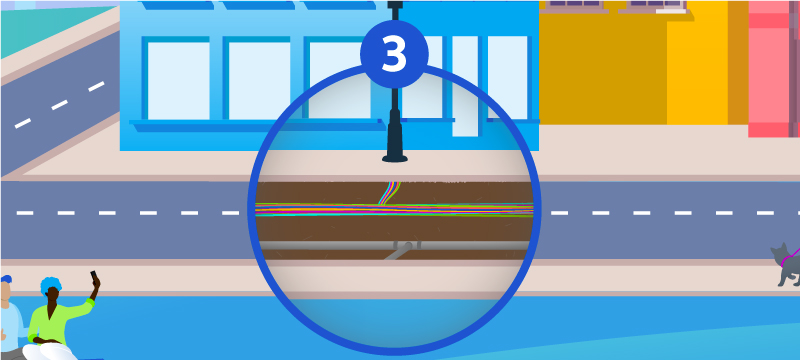We only build cell sites where needed to improve service
Think of small cells as a mini- cell sites — they support traditional macro cell towers by bolstering coverage and capacity in targeted areas where it’s most needed. Low profile, compact, scalable and unobtrusive, small cells improve network performance by densifying our network (in other words, bringing sites closer to the customer), meaning data doesn’t have to travel as far.
We seek to attach to existing structures first and install new poles only when existing structures are unavailable
Small cells are typically used in dense urban environments with lots of demand for service and in challenging geographic environments that create coverage gaps. When placed outdoors, small cells are generally attached to existing utility poles, light poles, traffic lights in the right-of-way, but in some circumstances can be attached to exterior walls of buildings. Small cells cannot replace macro cell towers and instead complement their coverage where larger towers simply won’t fit.
We consider a variety of factors. Applicable siting and permitting requirements are always taken into account. We also look to see where we might have potential performance challenges within the network and use that data to help guide where we need to target small cells. Speed, cost, flexibility and scalability are all vital to determining if small cells are the right fit.
We take health and safety seriously
We rigorously comply with applicable local construction requirements and with the FCC’s standards for radio frequency exposure.
We only build cell sites where needed to improve service
Think of small cells as a mini- cell sites — they support traditional macro cell towers by bolstering coverage and capacity in targeted areas where it’s most needed. Low profile, compact, scalable and unobtrusive, small cells improve network performance by densifying our network (in other words, bringing sites closer to the customer), meaning data doesn’t have to travel as far.
We seek to attach to existing structures first and install new poles only when existing structures are unavailable
Small cells are typically used in dense urban environments with lots of demand for service and in challenging geographic environments that create coverage gaps. When placed outdoors, small cells are generally attached to existing utility poles, light poles, traffic lights in the right-of-way, but in some circumstances can be attached to exterior walls of buildings. Small cells cannot replace macro cell towers and instead complement their coverage where larger towers simply won’t fit.
We consider a variety of factors. Applicable siting and permitting requirements are always taken into account. We also look to see where we might have potential performance challenges within the network and use that data to help guide where we need to target small cells. Speed, cost, flexibility and scalability are all vital to determining if small cells are the right fit.
We take health and safety seriously
We rigorously comply with applicable local construction requirements and with the FCC’s standards for radio frequency exposure.
Over the past decade, consumers have used an unparalleled amount of data. In 2019, Americans used 4,416,720 gigabytes of internet data every minute. That’s a 41% increase from 2018! That’s why making sure we bring you the best mobile network — which has seen a 580,000% increase in data traffic since 2007 — is a top priority.
To provide the quality and reliable wireless service everywhere you live, work and play, we use a variety of technologies — including macro towers and small cells — to build, upgrade and enhance our network.







